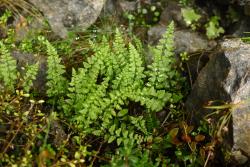Terrestrial ferns. Rhizomes short-creeping (NZ) or long-creeping or rarely erect (not NZ), scaly. Fronds monomorphic, not articulated to rhizome. Laminae 1–3-pinnate (NZ) or rarely 3-pinnate-pinnatifid (not NZ), anadromous or catadromous, herbaceous, glabrous or scaly or hairy. Veins free, terminating at the leaf margin. Sori round or slightly elongate on veins, borne on abaxial surface away from margins; receptacles raised and hardened (NZ) or flat (not NZ); paraphyses absent; indusia present (NZ) or absent (not NZ), attached at base, inflated and curving hood-like over the sporangia; sporangial maturation mixed. Sporangia with vertical annulus, usually 64 spores per sporangium. Homosporous; spores monolete, lacking chlorophyll; perispores echinate (NZ) or tuberculate or with broad folds and sometimes perforate (not NZ).
A family of 3 genera and about 37 species (PPG 1 2016).
Rothfels et al. (2012) undertook a family-level classification for the eupolypod II clade of leptosporangiate ferns, one of two major clades within the eupolypod ferns. The latter, together with Lindsaeaceae, Saccolomataceae, Dennstaedtiaceae, and Pteridaceae, makes up the Polypodiales. Rothfels et al. (2012) argued that the eupolypod II clade was still poorly understood at the time of the classification proposed by Smith et al. (2006), and they therefore presented a new classification derived largely from published molecular studies.
The relationships of the genera they included within Cystopteridaceae had previously been subject to very different interpretations. Kramer (1990) included them within subfamily Athyrioideae in a very broadly construed Dryopteridaceae. Smith et al. (2006) placed them within the athyrioid ferns (Woodsiaceae), which they separated from the dryopteroid ferns (Dryopteridaceae). Pichi Sermolli (1977) and Wang et al. (2004) included them in Athyriaceae, from which Woodsia and its segregates were removed into a much-reduced Woodsiaceae. Rothfels et al. (2012) went a step further and subdivided Athyriaceae into five further families, separating off four small groups from the much larger Athyriaceae. These included Cystopteridaceae, Diplaziopsidaceae, Rhacidosoraceae, and Hemidictyaceae, with the latter three in many respects somewhat closer to Aspleniaceae. Cystopteridaceae includes three main genera, Acystopteris, Cystopteris, and Gymnocarpium, with a few other small segregates sometimes recognised. Only Cystopteris occurs in New Zealand.
The family Cystopteridaceae comprises terrestrial ferns with short- to long-creeping scaly rhizomes, veins that terminate at the leaf margin. Indusia, when present, are hood-like, attached at the base and arching over the sporangia.
A family found primarily in temperate regions, often in montane habitats. Cystopteris and Gymnocarpium are common ferns of north temperate regions, while Cystopteris also occurs in the southern temperate zone, and Acystopteris in tropical east Asia. One non-endemic genus with two species in New Zealand; none endemic.
| Category | Number |
|---|---|
| Indigenous (Non-endemic) | 1 |
| Exotic: Fully Naturalised | 1 |
| Total | 2 |




